PostgreSQL Maestro 25.9 released
Sep 26, 2025
| Prev | Next |
|
SQL Maestro Group is happy to announce the release of PostgreSQL Maestro 25.9,
a powerful Windows GUI solution for PostgreSQL administration and database development. Please consider the list of new features implemented in this version since the last official release: |
New feature highlights:
- This version of the software has been successfully tested with all database server versions up to PostgreSQL 18.
-
Support for virtual generated columns has been added (PostgreSQL 18).
In the previous server versions, stored generated columns were only supported. Unlike stored generated columns, virtual generated columns occupy no storage and are computed when they are read.
To create a virtual generated column, just provide the generation expression in the Expression edit box of the Field Editor.
 Picture 1. Create a virtual generated column
Picture 1. Create a virtual generated column
To create a stored generated column, additionally turn ON the Stored checkbox.
In Data Grids and Data Input Forms stored and virtual generated columns are marked by green and blue calculator icons, respectively. Picture 2. Create a stored generated column
Picture 2. Create a stored generated column
 Picture 3. Generated columns in data grids
Picture 3. Generated columns in data grids
Starting from this version, it is possible to change (PostgreSQL 17+) and delete (PostgreSQL 13+) expressions of generated columns.
-
Support for NOT ENFORCED check and foreign key constraints (PostgreSQL 18) has been implemented. Constraints created with the NOT ENFORCED option are defined but not enforced to validate data.
NOT ENFORCED constraints can be useful as documentation if the actual checking of the constraint at run time is too expensive.
To make a constraint not enforced, just turn ON the appropriate checkbox in the Constraint Editor.
NOT ENFORCED check and foreign key constraints are displayed with a grayscale icon in the GUI.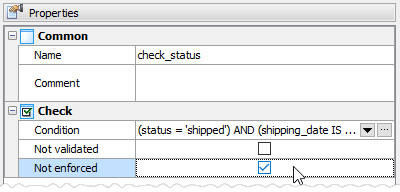 Picture 4. Check editor: Not enforced check constraint
Picture 4. Check editor: Not enforced check constraint
-
Support for named NOT NULL constraints (PostgreSQL 18) has been implemented.
Unlike previous versions where NOT NULL constraints were anonymous, it is possible now to give them meaningful names and comments.
You can view NOT NULL constraints defined on the table and manage them in the NOT NULL constraints tab of the Table Editor.
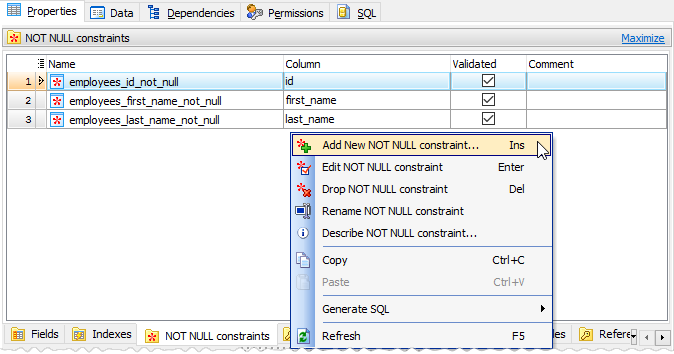 Picture 5. Manage NOT NULL constraints
Picture 5. Manage NOT NULL constraints
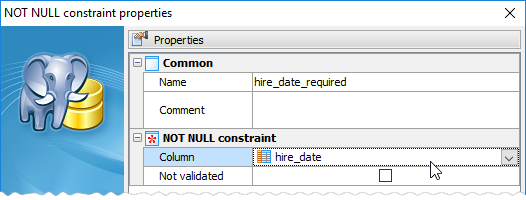 Picture 6. NOT NULL constraint editor
Picture 6. NOT NULL constraint editor
-
Support for the NOT VALID option for NOT NULL constraints (PostgreSQL 18) has been added.
NOT NULL constraints created with the NOT VALID option are enforced immediately and do not validate existing data.
It is very useful for large tables, where scanning to verify constraint can take a long time.
To create a NOT NULL constraint with NOT VALID option just check the Not validated option in the NOT NULL constraint editor.
Icons for not validated NOT NULL constraints are marked with a red exclamation mark in GUI.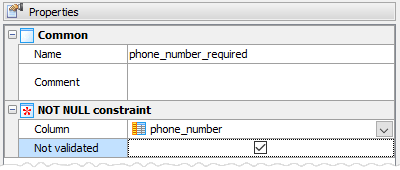 Picture 7. Adding NOT NULL constraint with NOT VALID option
Picture 7. Adding NOT NULL constraint with NOT VALID option
To validate a NOT NULL constraint that was previously created as NOT VALID use the Validate constraint command from the popup menu.
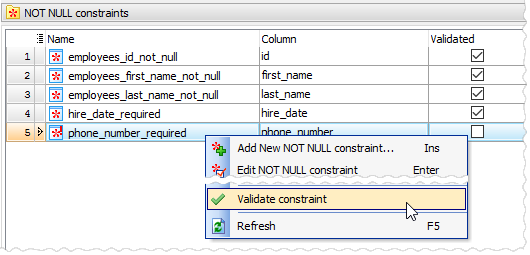 Picture 8. Validate constraint command
Picture 8. Validate constraint command
 Picture 9. Validate constraint SQL
Picture 9. Validate constraint SQL
-
Support for the NOT VALID option for check and foreign key constraints has been implemented.
This option has been available on the server for a long time but was missing in the product until now.
When check and foreign key constraints are created with the NOT VALID option, they are applied immediately without being validated against existing data.
Similar to unvalidated NOT NULL constraints, unvalidated check and foreign key constraints are marked with a red exclamation mark in GUI and can be validated using the Validate constraint command from the popup menu.
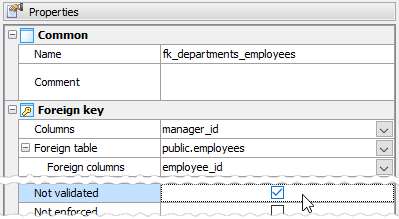 Picture 10. Adding foreign key constraint with NOT VALID option
Picture 10. Adding foreign key constraint with NOT VALID option
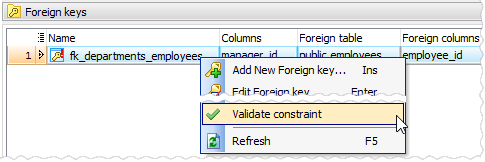 Picture 11. Validate foreign key
Picture 11. Validate foreign key
- Starting from this version, the ALTER TABLE ... RENAME CONSTRAINT ... syntax is used to rename constraints. Previously, renaming a constraint required recreating it.
- All software of our PostgreSQL family have been upgraded and come now with PostgreSQL 18 compatibility.
In addition to this, several bugs have been fixed and some other minor improvements and corrections have been made.
Related links
| Prev | Next |








